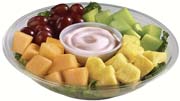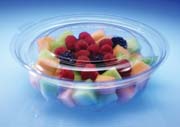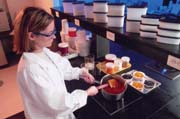
Photo courtesy of Wendy’s International Inc.
"The scientific research continues to build on the importance of dairy's powerful nutrient package-especially in light of concerns about Americans not getting enough of certain key nutrients, many of which are found in milk and milk products," says Clay Hough, senior v.p. and general counsel, IDFA. With that said, could dairy also act as a vehicle to deliver some of that two cups of fruit we are suppose to eat every day?
The answer is yes. How much fruit varies by product, and depends upon the innovative formulating efforts of product development teams.
Even fast-food chain Wendy's International Inc., Dublin, Ohio, recognizes that dairy and fruit are natural complements. Right after the dietary guidelines were issued, the company began offering an entree-sized fresh fruit bowl with low-fat, strawberry-flavored yogurt for dipping. Appealing to two dietary guideline recommendations (more fruit and dairy), "We're giving our customers an easy, convenient way to add more fruit to their daily diet," says Tom Mueller, president and COO, Wendy's North America.
Indeed, including fruit with dairy, or fruit ingredients in dairy foods appeals to consumers, particularly those concerned with health and wellness. Not only does fruit contribute to a dairy product's vitamin and mineral profile, fruits are virtually free of fat and also provide fiber, another nutrient that the dietary guidelines recommend Americans increase.

Photo courtesy of NatureWorks LLC
Available fruit ingredients
Seldom, if ever, are fresh fruit ingredients used in the manufacture of dairy foods. The reasons vary from food safety and convenience to quality and availability.Frozen fruit is often used, as frozen fruits are convenient to work with and, an added plus, many frozen fruits are actually more nutrient-dense than their fresh counterparts. This is because frozen fruits usually undergo the freezing process within a couple of hours of harvesting; thus, they retain more nutrients than some fresh fruits, which degrade during storage, shipping and time spent sitting in the produce aisle. Fruit ingredients sold frozen tend to be bulk-frozen, alone or with added sweeteners, or individually quick-frozen (IQF), a process that helps to minimize damage to fruits' texture and nutritional value.
Liquid juices and purées are also common fruit ingredients, particularly for dairy products. Juices can be single-strength or concentrated to varying strengths. Purée is fruit that is crushed, heat- or enzyme- treated to remove pectin and starch, filtered, concentrated to remove water, packaged and sometimes frozen. Highly concentrated juices and purées can be used to naturally color dairy foods without contributing much in the way of flavor or sweetness.
Juices and purées can also be used in dairy foods to simply add sweetness, as fructose, which is about 20% sweeter than sucrose, is abundant in fruits. Consumers often find dairy foods "naturally sweetened with fruit juice" to be more appealing than those containing sugar or non-nutritive sweeteners.
Keep in mind, fruit ingredients, with their naturally occurring fructose, can sweeten dairy foods naturally, and contribute to the dairy product's total fruit content. However, using fruit as a sweetener is not as cost effective as using most nutritive and non-nutritive sweeteners.

Photo courtesy of Degussa
Lastly, fruits can be heat-processed and packaged in bulk containers that require refrigeration. Additional heat processing, including a sterilization step, enables fruit to be either canned or aseptically packaged in flexible film. Such products are stable at ambient temperature. Heat-processed fruits tend to include sweetener and stabilizer, and often resemble pie filling. The aseptic products seldom have piece identity, as it is necessary that the fruit ingredient be uniform in consistency in order to ensure sufficient heat treatment for shelf stability.
With numerous varieties and forms of fruit to choose from, and an endless array of colors, flavors and textures, formulating dairy foods with fruit ingredients is a product developers' dream, as the opportunities are infinite. Let's make the dairy case another place in the supermarket where consumers can seek out fruit-rich foods and beverages.

Sidebar: Promoting Fruit Content Using ORAC Values
It's one thing to label dairy foods as being made with "real fruit" or "sweetened naturally with fruit juice." It's another to take the inclusion of fruit to the next level by flagging the fruit's ORAC value.ORAC, the acronym for oxygen radical absorbance capacity, is a measure of total hydrophilic antioxidant capacity. It does not measure the ability to prevent the formation of oxidants, rather it quantifies the ability of a compound to reduce the formation of free radicals.
What are free radicals? "Under most living conditions, humans are subjected to physiological and environmental stresses that overwhelm their bodies' natural defenses, often resulting in the production of free oxygen radicals, which can damage DNA, damage cells, initiate carcinogenesis and oxidize low-density lipoproteins, a step in the direction of heart disease," says Ginny Bank, v.p. of research and development, RFI Ingredients, Blauvelt, N.Y. "Endogenous antioxidants produced by the body can prevent free radicals from forming. In addition, it is helpful for humans to supplement the body's natural defenses with antioxidants from other sources. Thus, quantifying the antioxidant capacity of foods is useful."
ORAC assays measure the scavenging capacity of antioxidants in nutrients or in vivo against the peroxyl radical, which is one of the most common reactive oxygen species found in the body. High ORAC values correlate to high free radical scavenging ability. Thus, ORAC values are becoming an increasingly useful tool for consumers who are seeking out foods that contribute to overall health and wellness.
"ORAC values are becoming more prevalent in marketing efforts by select food and beverage manufacturers," says Bank. "The supplement industry has been highlighting ORAC values for some time now."
Are ORAC values useful or confusing? The answers are yes and yes. Consumers seem to grasp the concept that a high ORAC value is a good thing. But, confusion can set it when ORAC is quantified in the lab by one of a variety of assays, and in the way it is reported on product labels.
"The ORAC value of foods is often reported per 100g, while the ORAC value for supplements is reported per gram and often the units are completely left out," says Bank. These are just some of the issues regarding ORAC values, an unregulated, quantifiable food attribute.
"Resolving these issues won't be easy. It will take a concerted effort by the food and ingredient industry to promote ORAC values using the same language," concludes Bank. "Furthermore, as for validation of ORAC value in final products, it is the responsibility of the manufacturer to have a quality control mandate to guarantee ORAC values in the same way they guarantee other content claims."
Who knows, ORAC starbursts might soon replace net carbs on product labels.
